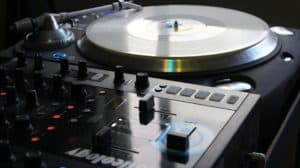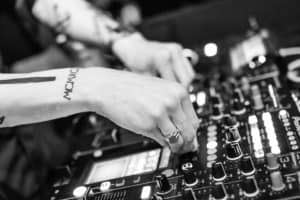When you start to get good at beat matching, you can start calling yourself an intermediate DJ. When you get to this point, most clients that you have will have a more difficult time finding a difference between you and a tenured professional DJ, so great work! This free DJ lesson will cover some of the most important intermediate DJ techniques that you need to know.
To make the push to professional level, you will need to get better at a few things. Many of the following techniques won’t come overnight, so don’t be disappointed if you can’t do a one of them for a little while.
Table of Contents
Transition Spontaneity

Odds are you are probably good at transitioning to a song without missing a beat if you are wanting to receive some more intermediate techniques, but you must also realize that transition techniques will always get more advanced and difficult. For example, an expert DJ will incorporate looping transitions, bridge transitions, chorus transitions, quick transitions, end-of-song transitions, and EQ/FX transitions all in one set, without missing a beat. If you want to learn what any of these are, keep reading.
Looping transition: A transition that occurs while one track is looping and the other is beginning. This is great to use in portions of the song that are repetitive, or with House or Hip-Hop music.
To do this transition, create a loop from the track that you want to transition from. Next, match the BPM of the looped track with the track you want to transition to, then press play on the first beat of a measure. Then slowly (or quickly, depending on the sound) move the crossfader over to the new channel.
Bridge transition: This transition is rather simple to do if you are good at song selection, and routinely set up cue points for your tracks. This transition is accomplished by changing the song at the first beat of a bridge of one song to the first beat of a bridge of another song.
In essence, what you are doing is transitioning the song right at the bridge. This is ideally done by quickly moving the crossfader over, so that the audience only hears the new bridge.
Chorus transition: This is a rather popular technique, and perhaps one that you have tried. This type of transition works very well with tracks that blend well together:
To do this transition, start your new track either on the first beat, or halfway through, the chorus of the song you are transitioning from (depending on how long your new track’s intro is). Make sure you time it correctly to make it so that the new song’s lyrics start right when the chorus of the old song ends.
While doing this transition, make sure you cut the bass of your old song to make room for your new song. This also allows the audience to get a preview of where you are going with your mix.
Quick transitions: These types of transitions are simply when you start one song immediately after the last beat in a measure of another song. These are the quickest type of transition you will do as a DJ, thus why they are called “quick” transitions. These are one of the first types of transitions learned by beginners.
End-of-Song Transitions: This is also a beginner technique, and one that is learned along with beat-matching. This type of transition is simply moving the crossfader over to a new song at the end of an old song, but on beat of course.
EQ/FX Transitions: Your EQ and FX settings can also help you to transition between songs. Usually, the exact details on how to do this is subjective to the type of setup you have. If you want to learn some EQ/FX transitions, play around with your setup until you discover some new ideas.
Proper EQing

Disclaimer: you will have a hard time finding a DJ who keeps their EQs set right in the middle for their Lows, Mids, and Highs. Instead, realize that each song requires new EQ settings. If you want to be a professional DJ, you need to train your ears to become your biggest asset.
At the start of your set, and at the beginning of each song, make sure that there isn’t a single flaw in your mix. If there is, simply EQ it out. There are also mixers which have low-pass and high-pass filters which are incredibly helpful in this process.
Your voice is another thing which you need to learn how to EQ. Many professional DJs have their own settings which they use to make their voice sound good on the microphone. Of course, there are no “magic settings” to make your voice sound good, and this will require some homework on your part.
Perfecting the Drop
The drop has become one of the greatest assets of the DJ in recent years. This is thanks to the introduction of EDM and Twerk music, which heavily relies on a good drop to get people dancing.
To perfect your drop you will need to keep your options open. You don’t want to constantly be reverting back to the same technique over and over. To help you switch things up, here are a few more techniques which can help you perfect your drop.
Building EQs: This is the easiest, and perhaps most popular form of building a drop. This technique is simple, as the drop builds up you need to gradually cut the bass and boost the highs. This should be timed perfectly so that you completely cut the bass, and completely boost the highs, right before the drop so that you can quickly revert your EQ settings back.
The Key Drop: Have you ever heard a DJ build up a drop for so long that you start to wonder how they are doing it? For example, a loop can only build a drop for so long, right? After all it’s just one part of a song.
Well, the truth is that you can take a short loop, 8 bars for example, and use it to create a 2-minute drop. To do this, all you need to do is gradually make the key of your song go up (most DJ software can do this) until you are satisfied with your drop, and then let the bass kick.
The Drop Killer: As a DJ, you don’t want to be predictable. In fact, you want to be unpredictable, otherwise your clients’ ears will get bored and you probably won’t get hired back.
The Drop Killer is exactly what it sounds like. Instead of playing the drop of every song, simply cut it sometimes and transition over to a new song. This will show the audience that you have a large amount of skills in your DJ repertoire, and is helpful for those songs that have an amazing build, but terrible chorus.
The Law of Three

This technique comes natural to some DJs, others need to be told. To put it simply, you do not want to constantly be going from one genre to another.
To make your sets sound good, start picking bunches of three tracks that sound good together. This way, you will always ensure that most of your transitions sound perfect, and you can always go wherever you want to go with your set at the end of those three tracks.
Doing this helps you to slowly move from one type of music to another, giving your niche audience the comfort to be on the dancefloor for 10-15 minutes at a time, as opposed to 3-5 minutes at a time.
Another thing to keep in mind: constantly updating and creating new playlists will help you to spot out bunches of tracks that flow well together. If you want an easy way to create groups of three, create good playlists that you can look at during your set.
Adding Acapellas
Adding acapella tracks is something usually left for expert DJs, but today’s technology allows intermediate DJs to do this as well.
Since most DJ software allows you to scope out the BPM and key of a track, even if it is acapella, you will discover that mixing an acapella with an instrumental is actually a relatively easy thing to do.
There are only a couple things you will need to look out for if you want to try out this technique. First, you will need more than 2 channels on your software, because if you are to transition properly, you will need a 3rd channel in this case.
Secondly, you need to make sure that the key of the acapella matches with the instrumental. If you train your ears, you start to learn what keys go well together.

Once again:
With practice, each of these techniques will come naturally to you. Once you start to master these techniques, you will be more than ready to move on to more advanced techniques, such as scratching. We hope you enjoyed your free DJ lesson! For more free DJ lessons check out: how to use CDJs or how to use a controller.
